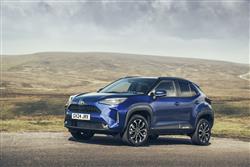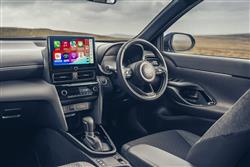Toyota Yaris Cross - ABC Leasing
How will you view?
This is a sample, showing 30 seconds of each section.
CROSS PURPOSES(some text hidden)
By Jonathan Crouch
Ten Second Review word count: 68
In this Yaris Cross, Toyota has a credible truly class-competitive supermini-sized SUV. The Yaris Cross fills an important gap in the company's Crossover line-up, just below the C-HR, and gets a useful update here. Its full-Hybrid powerplant is still the most frugal in the segment and there's also class-leading safety and the unusual option in this class of AWD if you want it. Potentially, lots to like then.
Background word count: 190
There are many supermini-based crossover SUVs now on the market, but few of them seem to have hit the B-segment sweet spot quite like Toyota's little Yaris Cross. It was introduced back in 2021 and quickly became a brand favourite and a segment strong seller prior to the light mid-term update we look at here, announced in late 2023. That's brought us a more digitalised cabin and a wider raft of safety features. As before, for our market anyway, it comes only with a full-Hybrid engine, but the 1.5-litre unit is now available with a choice of outputs. This powerplant isn't a token gesture mild hybrid like you'd get in, say, that rival Ford Puma or, perhaps, a Kia Stonic, but a full-fat petrol/electric powertrain that doesn't need plugging in but can run all-electrically some of the time. A few rivals in this segment can now offer that but none of them can provide this confection with 4WD, an option for this Yaris Cross at the top of the range. If your interest in this improved Yaris Cross is starting to grow, you might be interested to check it out.
Driving Experience word count: 269
Under the bonnet, the 1.5-litre full-Hybrid self-charging petrol/electric powerplant is of course the same one that's fitted to the conventional Yaris supermini, which means that as there, you can now get it in two states of tune. Most customers will continue with the previous 114bhp output version, but you can now get this engine in a perkier 129bhp state of tune, with torque increased by 30% from 141Nm to 185Nm. That improves the 0-62mph sprint time by half a second to 10.7s. All Yaris Cross models continue with the same e-CVT auto gearbox. And the Hybrid engine continues with its pleasing preference for reverting to battery power in urban driving whenever possible. As a result, the company expects that over 80% of urban journeys in this car will be able to be completed under electric power alone. Toyota says it's put a lot of work into reducing noise and vibration with this revised model, with thicker windscreen glass, more sound deadening and a dynamic damper added to the left-side engine mount - amongst other changes. As before, along with the front-driven drivetrain bolted to the Yaris model line's stiff TNGA platform, there's something unusual in this class - the option of 4WD. The 'Intelligent All-Wheel Drive' system in question is, as you'd expect, of the electric rather than the mechanical kind and operates in front wheel drive most of the time, sending drive to the rear wheels only when tractional needs really require it to. This AWD-i version gets a more sophisticated double-wishbone rear suspension set-up too, compared to the front wheel drive car's more basic torsion beam arrangement.
Pictures (High res disabled)

.jpg)
.jpg)
.jpg)
.jpg)
.jpg)
.jpg)
.jpg)

Scoring
Category: Compact Car
| Performance | |
| Handling | |
| Comfort | |
| Space | |
| Styling | |
| Build | |
| Value | |
| Equipment | |
| Economy | 90% |
| Depreciation | 70% |
| Insurance | 70% |
| Total | 68% |